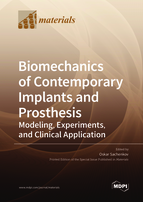Biomechanics of Contemporary Implants and Prosthesis: Modeling, Experiments, and Clinical Application
A special issue of Materials (ISSN 1996-1944). This special issue belongs to the section "Biomaterials".
Deadline for manuscript submissions: closed (15 July 2022) | Viewed by 26236
Special Issue Editor
Interests: biomechanics; bone tissue; hip dislocation; osteotomy; acetabulum; computed tomography; FEA; CT based FEM
Special Issues, Collections and Topics in MDPI journals
Special Issue Information
Dear Colleagues,
Modern medicine is more oriented towards patient-based treatments. Taking into account individual biological features allows for increasing the quality of the healing process. Opportunities for modern hardware and software allow not only simulating the complex behavior of implants and prostheses but taking into account any peculiarities of the patient. Moreover, development of the additive manufacturing expands the opportunities for materials. Technical limits for composite materials, biomaterials, metamaterials are decreasing. On the other hand, there is a need for more detailed analyses of biomechanics research. A deeper understanding of the technological processes of implants, and the mechanobiological interaction of implants and organisms will potentially allow us to raise the level of medical treatment.
In this Special Issue, modern trends of the biomechanics of contemporary implants and prostheses, including experimental and mathematical modeling and clinical application, are highlighted and discussed.
I am pleased to invite you to submit a manuscript for this Special Issue. Full papers, communications, and reviews are all welcome.
Topics of interest include (but are not limited to):
- New methods of design implants and prosthesis;
- Digital solutions for the patient-based treatment;
- CT and MRI based biomechanical simulation;
- Usage of biomaterials for implants and prosthesis;
- Research of biocompatibility for implants and prosthesis;
- Usage metamaterial for implants;
- Influence of the patient's biomechanics on implant loading
Dr. Oskar Sachenkov
Guest Editor
Manuscript Submission Information
Manuscripts should be submitted online at www.mdpi.com by registering and logging in to this website. Once you are registered, click here to go to the submission form. Manuscripts can be submitted until the deadline. All submissions that pass pre-check are peer-reviewed. Accepted papers will be published continuously in the journal (as soon as accepted) and will be listed together on the special issue website. Research articles, review articles as well as short communications are invited. For planned papers, a title and short abstract (about 100 words) can be sent to the Editorial Office for announcement on this website.
Submitted manuscripts should not have been published previously, nor be under consideration for publication elsewhere (except conference proceedings papers). All manuscripts are thoroughly refereed through a single-blind peer-review process. A guide for authors and other relevant information for submission of manuscripts is available on the Instructions for Authors page. Materials is an international peer-reviewed open access semimonthly journal published by MDPI.
Please visit the Instructions for Authors page before submitting a manuscript. The Article Processing Charge (APC) for publication in this open access journal is 2600 CHF (Swiss Francs). Submitted papers should be well formatted and use good English. Authors may use MDPI's English editing service prior to publication or during author revisions.
Keywords
- implants and prosthesis
- personal aided treatment
- CT and MRI based simulation
- biomaterials and biocompatibility
- metamaterial implants
- patient's biomechanics and implant’s loading
- metallic and composite structures







